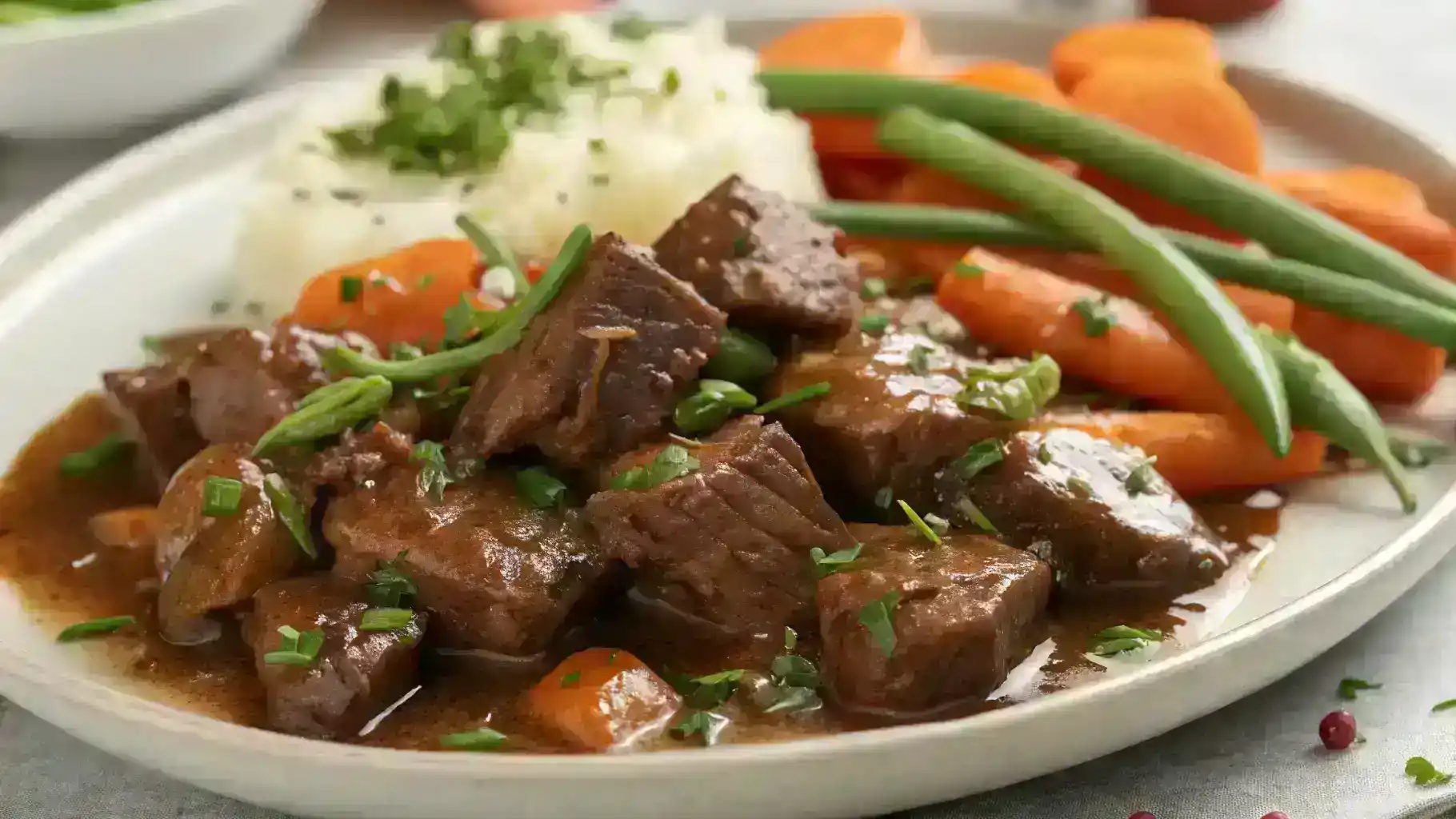A classic beef tips recipe gives you countless ways to enjoy this hearty, satisfying meal – whether you serve it over egg noodles, rice, or mashed potatoes. In fact, this soul food staple has been the life-blood of family gatherings and comfort dining.
Making perfectly tender beef tips takes more than just tossing meat in a pot. You’ll need patience to achieve that melt-in-your-mouth texture. The cooking process can take 90 minutes to 2.5 hours on the stovetop, or 7-8 hours in a slow cooker. The good news? You only need a few simple ingredients like beef, onions, garlic, and broth to create this impressive dish.
Our guide walks you through each step to create restaurant-worthy beef tips and gravy. You’ll learn everything from selecting the best cuts of meat to creating that rich, velvety sauce. Let’s delve into the secrets of this timeless comfort food classic!

Table of Contents
Understanding Beef Cuts for Perfect Beef Tips Recipe
A successful beef tips recipe starts with picking the right cut of meat. Many home cooks think any cubed beef will work, but your choice of cut substantially affects the texture and flavor of your dish.
Best Cuts for Tender Beef Tips
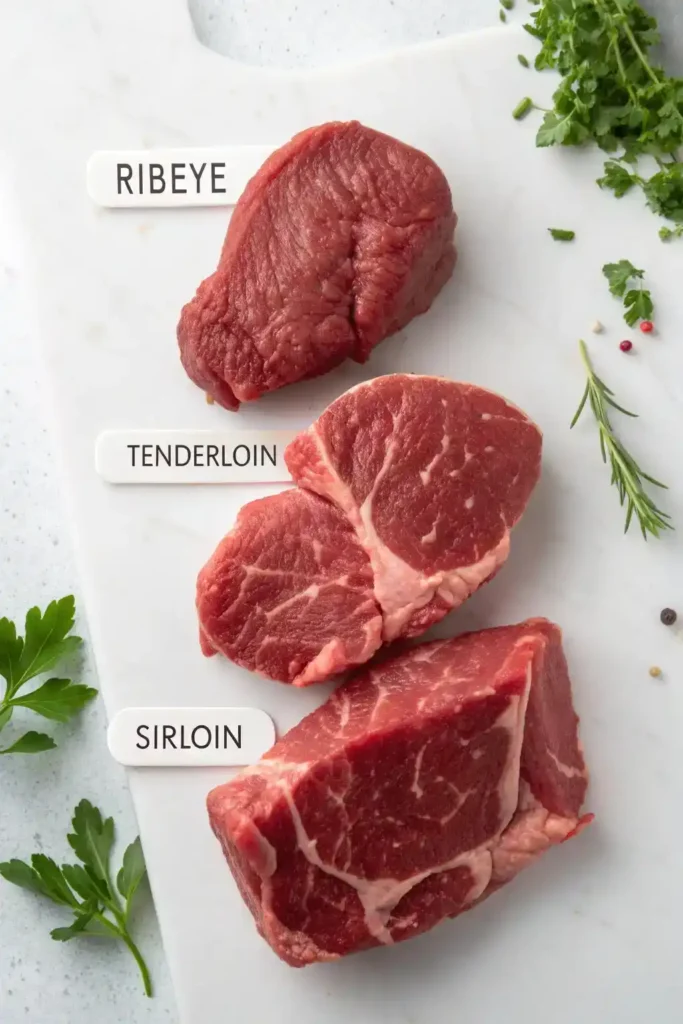
Beef tips traditionally come from the tenderloin tip, but this term now describes any dish with cubed beef in gravy. The most tender results come from well-marbled cuts.
Chuck roast stands out as the best choice for beef tips and gravy. This budget-friendly cut has the perfect balance of fat and connective tissue that breaks down while cooking to give you melt-in-your-mouth bites. Look for pieces that show marbling throughout when you’re buying chuck.
Sirloin (especially top sirloin) works great for quick-cooking beef tips recipes. While it’s not as tender as chuck after long cooking, sirloin gives you good flavor and tenderness when time is short. The “sirloin tip” comes from the top sirloin’s outer portion and makes excellent cubes.
Tenderloin creates the most tender beef tips but costs more. Since it’s naturally tender, tenderloin needs less cooking time than tougher cuts.
Budget-Friendly Options That Still Deliver
Your budget doesn’t have to limit you – several alternative cuts give excellent results:
- Stew meat saves time since it’s pre-cubed, but its tenderness can vary. Choose packages showing marbling and visible connective tissue.
- Eye of round gives you a lean, cost-effective option. Marinating before cooking and thin slicing against the grain after cooking helps make up for its natural toughness.
- Chuck eye steak – the “butcher’s steak” – sits next to the ribeye and offers similar qualities at a lower price. This hidden gem has excellent marbling and tenderness.
Cuts with more marbling and connective tissue become more tender beef tips when slow-cooked. Leaner cuts work better with quick-cooking methods.
How to Properly Trim and Prepare Your Beef
The right preparation is vital to maximize tenderness. Here’s how I prepare whole cuts like chuck roast:
- Leave only a thin layer (about ¼ inch) of surface fat for flavor.
- Make uniform cubes (1 to 1½ inches) to help everything cook evenly.
- Pat the cubes dry with paper towels before searing to get better browning.
Tougher cuts benefit from a tenderizing marinade with acidic ingredients like vinegar or citrus juice. Marinate for at least 6 hours but no more than 24 hours to avoid mushy meat.
The quickest way to get great searing is to avoid overcrowding your pan. Work in batches and give each piece of meat enough space. This approach ensures proper browning and creates deeper flavor in your finished beef tips.
Essential Ingredients for Classic Beef Tips and Gravy
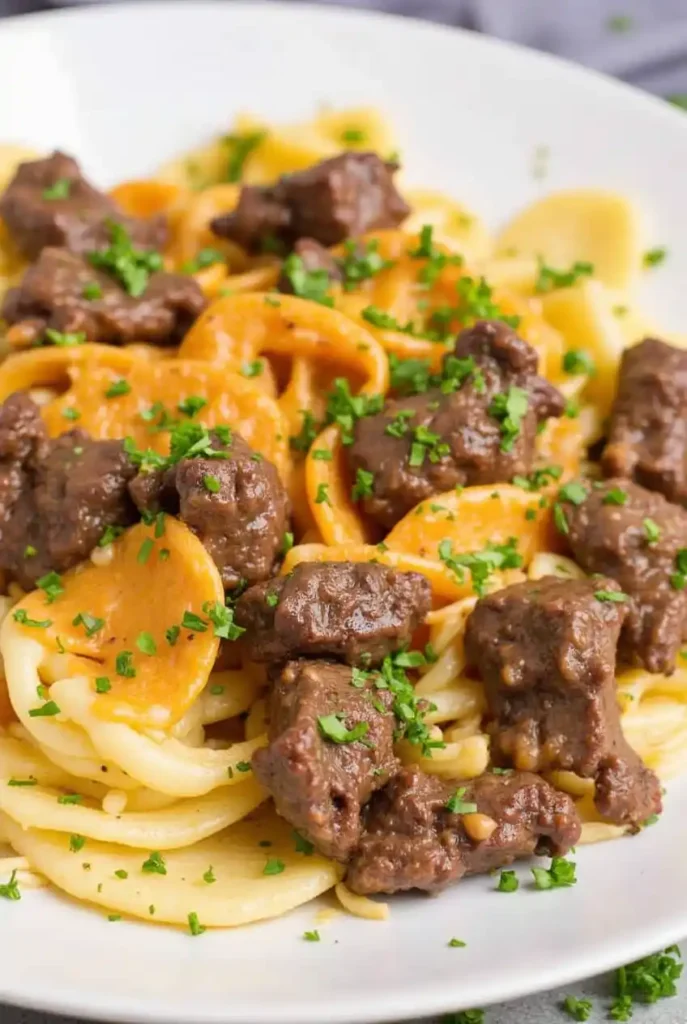
A delicious pot of beef tips starts with the perfect mix of ingredients. Simple components work together to create something magical. Let me show you the key elements that turn regular beef into an amazing meal.
The Foundation: Beef, Aromatics, and Broth
The perfect cut of beef is just the beginning – you need a solid flavor foundation too. Yellow onions and fresh garlic are the backbone of any great beef tips recipe. These ingredients create a savory base that spreads through the dish after they’re sautéed until soft.
Beef broth serves as the main cooking liquid. Low-sodium beef broth gives better control over seasoning. The combination of beef and chicken broth adds incredible depth. Chicken broth packs concentrated flavor compounds that improve the overall taste.
Your choice of cooking fat makes a difference. Vegetable oil works great to sear meat at high heat, while unsalted butter creates richer gravy. Sometimes I use both – oil browns the beef and butter makes the roux.
Secret Flavor Boosters
Great beef tips become exceptional with these flavor-enhancing ingredients:
- Worcestershire sauce: A single tablespoon transforms the gravy with complex umami notes.
- Soy sauce: This umami powerhouse brings out the beef’s natural flavors.
- Red wine: It deglazes the pan and mixes those tasty browned bits with fruity depth.
- Bacon or pancetta: Rendered bacon adds smoky richness before browning the beef.
Fresh herbs play a vital role. Thyme sprigs add earthy aromatics during braising. Fresh parsley adds bright, clean notes at the end.
I found that a touch of tomato paste or fish sauce magnifies the meaty flavor without being obvious.
Thickening Agents for the Perfect Gravy
The beef tips’ crowning glory is without doubt its velvety gravy. All-purpose flour remains the classic thickener, usually added in two ways:
You can make a roux by cooking flour with butter until it forms a golden paste. This method thickens and adds toasty notes to the gravy. A dark golden brown roux removes raw flour taste and deepens flavor.
A cornstarch slurry offers quick thickening without long cooking times. This works best to adjust thickness right at the end.
Gluten-free options include arrowroot powder, tapioca starch, or potato starch. Each one acts differently. Arrowroot makes glossier sauce but loses power with long cooking. Potato starch creates a more matte finish.
Whatever thickener you pick, add it slowly while whisking to avoid lumpy gravy.
How to Cook Beef Tips Recipe: Step-by-Step Instructions
The cooking process changes your carefully prepared ingredients into an unforgettable meal. The right techniques will give your beef tips that perfect balance of tenderness and flavor every time.
Properly Searing Your Beef for Maximum Flavor
Searing isn’t just the first step—it’s what builds all the flavor. Start by patting your beef cubes dry with paper towels and season them well. Here’s what you need to do:
- Heat a heavy-bottomed skillet or Dutch oven over medium-high heat until hot
- Add just enough vegetable oil to coat the bottom (olive oil has too low a smoke point)
- Place beef in a single layer with space between pieces—crowding leads to steaming instead of searing
- Each piece should cook without moving for 30-45 seconds per side
- The meat will naturally release from the pan once it’s properly seared—no need to force it
Note that you’re not cooking the beef through yet—it should finish cooking in the gravy where it soaks up all the flavor.
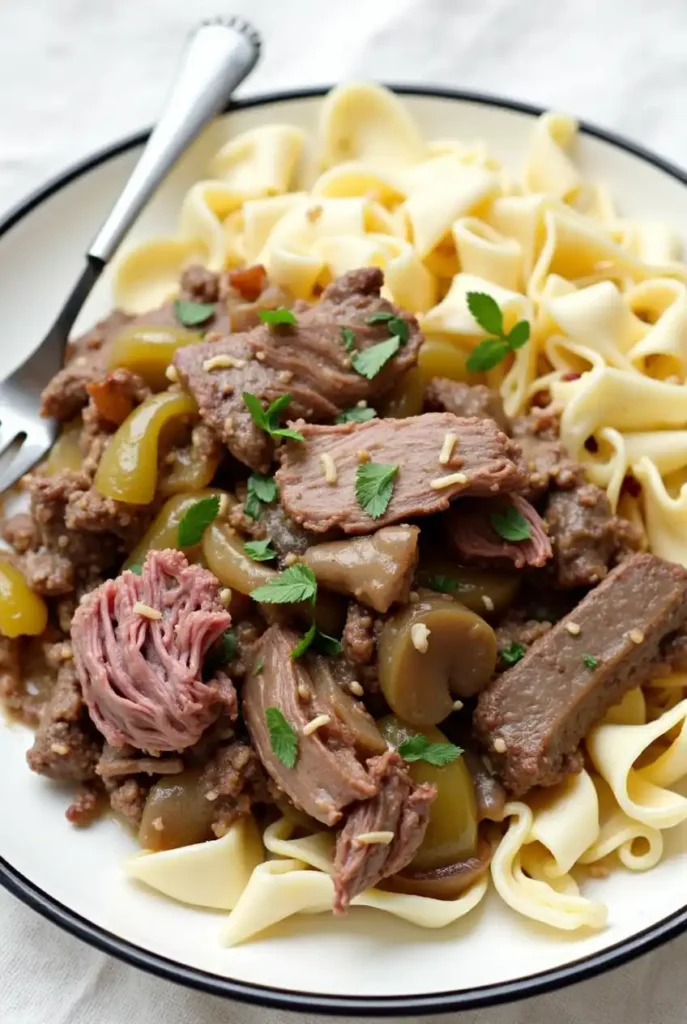
Creating a Rich, Savory Gravy
The real magic starts after removing the seared beef:
- Deglaze the pan with ¼ cup red wine (optional) and scrape those flavorful browned bits (called “fond”) from the bottom
- Lower heat to medium, add butter and chopped onions, then cook until soft (about 5 minutes)
- Add minced garlic and cook for another minute
- Add beef broth and flavor boosters (Worcestershire sauce, soy sauce, seasonings)
- Let the mixture come to a boil
You have options to thicken the gravy. A cornstarch slurry (cornstarch mixed with cold water) works fast when you whisk it in slowly. You could also sprinkle flour over sautéed onions to make a roux before adding liquid.
Simmering Techniques for Tender Results
Your cooking method determines tenderness once you’ve got your gravy base:
Stovetop Method: Put beef tips and their juices back in the pot. Let them simmer partially covered for 1.5-2 hours until fork-tender. This slow cooking helps collagen break down the right way.
Oven Method: After the mixture starts simmering on the stovetop, put your covered Dutch oven in a 325°F preheated oven for 1.5-2 hours.
Slow Cooker Method: Put your seared beef and prepared gravy in a slow cooker for easy cooking. Let it cook on low for 7-8 hours or high for 3-4 hours.
Stir occasionally during cooking and add small amounts of broth if needed to keep the meat mostly covered.
Testing for Doneness
The USDA recommends beef reach an internal temperature of 145°F with a 3-minute rest period. All the same, temperature alone won’t tell you if beef tips are ready.
Here’s how to assess tenderness:
- Fork Test: Well-cooked beef tips should break apart easily with a fork
- Texture Check: You should be able to cut the meat with little resistance
- Visual Inspection: The meat edges should show slight shrinkage
Put an instant-read thermometer into the thickest part of a beef piece for the most accurate reading, staying away from fat or bone.
A pro tip like restaurant chefs use—don’t keep poking the meat with thermometers while cooking since this lets precious juices escape. Test just one piece when you think it’s almost done.
Troubleshooting Common Beef Tips Problems
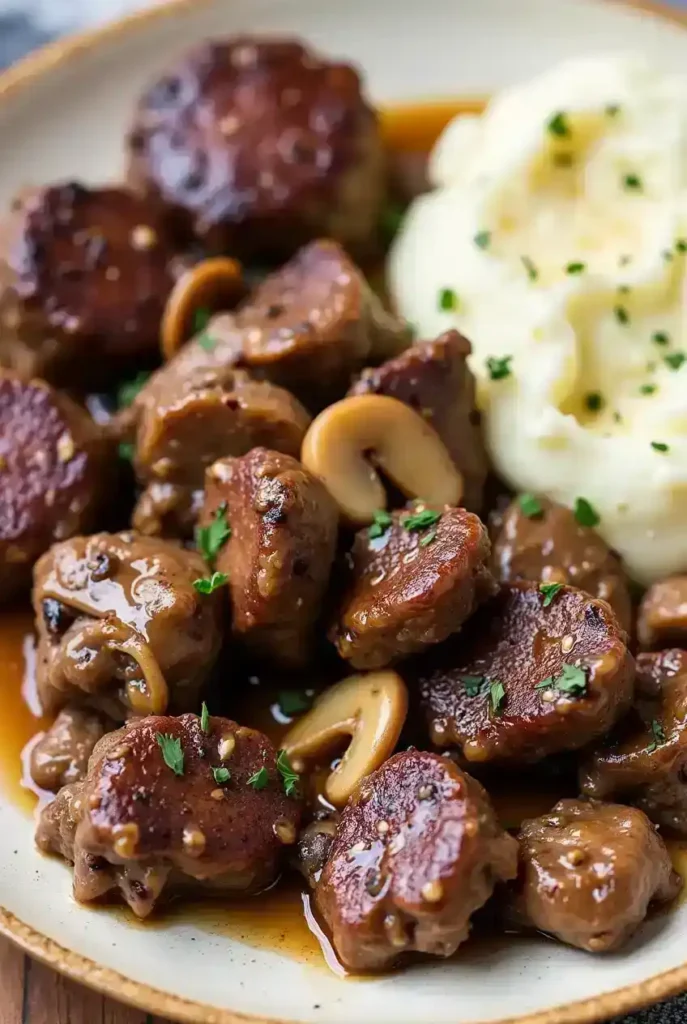
Beef tips can challenge even the most experienced cooks. The good news is that simple solutions can save your dish and help you achieve delicious results.
Why Your Beef Might Be Tough
Several common mistakes lead to tough beef tips. High cooking temperatures make the meat constrict and toughen. A gentle simmer works better than boiling throughout the cooking process. Think of giving your beef a soothing bath instead of a stress-inducing hot tub.
Most beef tips need 90 minutes to two hours on the stovetop to become tender. In stark comparison to this, slow cookers produce better results with 7-8 hours on low rather than shorter times on high.
Temperature shock happens with cold meat. Your beef should reach room temperature before cooking to ensure even tenderness.
Your choice of cut can make or break the dish. Lean cuts like tenderloin dry out and toughen with extended cooking. Collagen-rich cuts like chuck revolutionize into tender morsels.
Fixing a Thin or Lumpy Gravy
An immersion blender quickly fixes lumpy gravy. Just blend in the pot until smooth. You can also strain the gravy through a fine-mesh strainer or use a standard blender briefly.
A slurry of equal parts cold water and cornstarch (or flour) thickens thin gravy. Add it gradually while simmering. Note that gravy thickens more as it cools.
Raw flour in hot gravy creates lumps. The core team of experienced cooks first make a roux by cooking flour with fat until it bubbles before adding liquid.
Adjusting Seasoning and Flavor Balance
You can fix over-salted gravy by adding unsalted broth or water, though you’ll need to thicken it again. A splash of ginger ale or tiny pinch of sugar balances excessive saltiness.
Bland beef tips improve with Worcestershire sauce or soy sauce that adds umami depth without making the dish taste Asian or British. Red wine vinegar brightens the flavor and helps break down tough meat fibers.
The five key flavors—sweet, salty, sour, bitter, and umami—should complement each other. Balance dominant flavors with their counterpoints: sweetness reduces bitterness, acid cuts sweetness, and salt enhances most other flavors.
Serving and Pairing Your Beef Tips
Your beef tips presentation adds the final touch to transform simple preparation into a delightful meal. The right serving method can improve your dining experience after you become skilled at cooking this comfort food classic.
Traditional Accompaniments
The right foundation for your savory gravy makes beef tips taste perfect. Classic options include:
- Rice varieties: White or brown rice soaks up all the flavorful gravy and creates a complete meal easily. You might want to think about alternatives like garlic butter rice or pilaf for extra flavor.
- Potato perfection: Buttermilk or garlic mashed potatoes work as a creamy canvas that balances the rich beef flavors. Smashed potatoes or twice-baked potatoes add a nice texture contrast.
- Noodle options: Egg noodles are a traditional favorite because gravy clings to every strand. Simple buttered noodles with basic seasonings add flavor without overwhelming.
Roasted Brussels sprouts with crispy bacon create an earthy contrast. Fresh green beans or honey-glazed carrots bring color and nutrients to the plate. A simple Caesar salad or Greek salad adds a fresh element.
Wine and Beverage Pairings

Bold reds aren’t your only choice with beef. Some unexpected options are worth trying:
Rosé Champagne pairs surprisingly well with leaner cuts of beef and creates a unique taste experience. Cabernet Sauvignon works perfectly with ribeye cuts – its tannins balance the meat’s richness.
Malbec’s smooth texture matches tender cuts like filet mignon. Syrah (Shiraz) brings a bold, peppery profile that works great with hearty beef tips.
Make-Ahead and Reheating Tips
Beef tips taste better the next day, so you can make them ahead. Leftovers stay good in airtight containers in the fridge for 3-4 days or in the freezer for up to 3 months.
The stovetop gives the best results for reheating. Just put them in a skillet or saucepan over medium heat and stir now and then. A splash of beef broth helps if the gravy gets too thick during storage.
Single portions heat up well in the microwave – use 30-second intervals to avoid overheating. A slow cooker on low setting also works great to warm up refrigerated beef tips.
Conclusion
The perfect beef tips demand careful attention – from choosing the right cut to getting that ideal gravy consistency. Understanding each component of meat selection, ingredient prep, and cooking techniques guides you toward excellent results every time.
Tender, flavorful beef tips need time and care. Chuck roast works best for slow cooking, while sirloin suits quicker meals. The magic happens when flavors develop fully to create those restaurant-quality dishes you love.
Rich flavors emerge through proper searing, gravy-making, and thoughtful side pairings. Of course, these savory morsels taste amazing over creamy mashed potatoes or perfectly cooked egg noodles. Simple ingredients lift an everyday meal into something special.
You can discover more comforting recipes and helpful cooking tips at recipesnutritious.com. Note that exceptional cooking combines proper technique with quality ingredients. You now have the knowledge to create perfect beef tips whenever you want.
FAQs
Q1. How can I ensure my beef tips are tender? To achieve tender beef tips, use well-marbled cuts like chuck roast, sear the meat properly, and cook low and slow. Simmer for 1.5-2 hours on the stovetop or 7-8 hours in a slow cooker to allow the collagen to break down, resulting in melt-in-your-mouth texture.
Q2. What’s the best way to create a flavorful gravy for beef tips? Start by deglazing the pan with red wine to incorporate browned bits. Then, create a base with sautéed onions and garlic. Add beef broth, Worcestershire sauce, and soy sauce for depth. Thicken with a roux or cornstarch slurry, whisking constantly to avoid lumps.
Q3. Can I make beef tips ahead of time? Yes, beef tips actually improve with time. You can prepare them in advance and store in the refrigerator for 3-4 days or freeze for up to 3 months. When reheating, add a splash of beef broth if the gravy has thickened too much during storage.
Q4. What are the best side dishes to serve with beef tips? Classic accompaniments include rice, mashed potatoes, or egg noodles to soak up the gravy. For vegetables, consider roasted Brussels sprouts, green beans, or honey-glazed carrots. A simple salad can add freshness to balance the rich flavors of the beef.
Q5. How do I fix tough beef tips? If your beef tips are tough, they likely need more cooking time. Ensure you’re simmering at a low temperature and give the dish more time to allow the collagen to break down. For already cooked tough beef, you can try slicing it thinly against the grain or using a meat tenderizer to break down the fibers.

